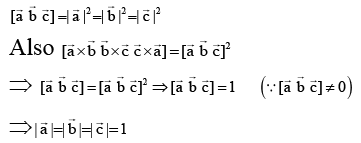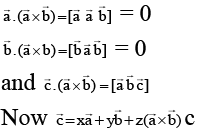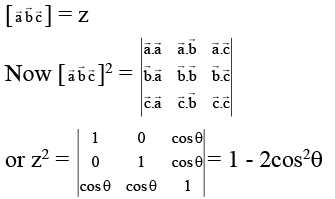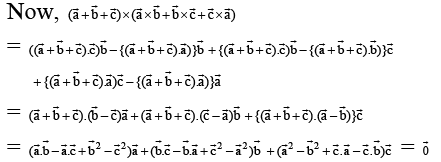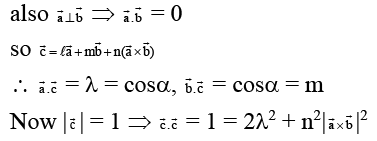JEE Advanced (One or More Correct Option): Vector Algebra | Chapter-wise Tests for JEE Main & Advanced PDF Download
Q.1. If  are non-coplanar vectors such that
are non-coplanar vectors such that  and
and  then
then
(a) 
(b) 
(c) 
(d) 
Correct Answer is option (a, c, d)
Q.2.  are unit vector such that
are unit vector such that  mutually perpendicular and
mutually perpendicular and  is equally inclined to
is equally inclined to  at an angle θ. If
at an angle θ. If  then
then
(a) z2 = 1 - 2y2
(b) z2 = 1 - x2 - y2
(c) z2 = 1 - 2x2
(d) x2 = y2
Correct Answer is option (a, b, c, d)
Hence a, b, c, d.]
Multiplying both sides scalarly by
cos θ = x .1 + 0 + 0 = x , cosq = y.1 = y= x.0 + y.0 + z(a × (b)2 = z.1 = z [a b c] = z
∴ z2 = 1 - 2x2 = 1 - 2y2
Also, x2 = y2
Q.3. Let  be three vectors. A vector in the plane of
be three vectors. A vector in the plane of  whose projection on
whose projection on  is of magnitude √2/3 is
is of magnitude √2/3 is
(a) 
(b) 
(c) 
(d) 
Correct Answer is option (a, c)
Let the required vector beFor this to be coplanar with
we must have
⇒ x(-4 + 1) + y(-1 + 2) + z(1 - 2) = 0
⇒ -3x + y - z = 0 ....(1)
The projection of
The choices (a) and (c) satisfy the equations (1) and (2).
Q.4. Which of the following statements is/are correct?
(a) If  and
and  for some non-zero vectors
for some non-zero vectors  then
then 
= 0
(b) There exist a vector making angles 30º and 45º with x and y axes respectively.
(c) Locus of point for which x = 3 and y = 4 is a line parallel to the z-axis whose distance from the z-axis, is 5.
(d) The vertices of a regular tetrahedron are O, A, B, C where 'O' is the origin. The vector  is perpendicular the plane ABC.
is perpendicular the plane ABC.
Correct Answer is option (a, c, d)
(a) sinceare coplanar
(b) cos230º + cos245º + cos2γ = 1
∴ sin2g =which is not possible.
(c) Obvious
(d)
i.e.,is perpendicular to the plane ABC.
Hence, the statement is true.
Q.5. If  then the vector
then the vector  is orthogonal to -
is orthogonal to -
(a) 
(b) 
(c) 
(d) 
Correct Answer is option (a, d)
and this is orthogonal to
is also orthogonal to
Q.6. Let the unit vector  are perpendicular and the moduli vector
are perpendicular and the moduli vector  inclined at an angle α to
inclined at an angle α to 

(a) λ = m
(b) n2 = 1 – 2λ2
(c) n2 = - cos 2α
(d) 
Correct Answer is option (a, b, c, d)
angle between= angle between

⇒ m = λ= cos α
⇒ 1 = 2λ2 + n2 ⇒ n2 = 1 - 2λ2 = 1 - 2cos2α
= - cos2α
Hence, all are correct.
Q.7. Let A be vector parallel to the line of intersection of planes P1 and P2 through origin. P1 is parallel to the vectors 2j + 3k and 4j – 3k and P2 is parallel to j – k and 3i + 3j, then the angle between A and 2i + j – 2k is -
(a) π/2
(b) π/4
(c) p/6
(d) 3p/4
Correct Answer is option (b, d)
vectoris parallel to
[(2j + 3k) × (4j – 3k)] × [(j – k) × (3i + 3j)] ⇒ 54 (j – k)
If θ is the required angle then
Q.8. If the vectors  are coplanar, then -
are coplanar, then -
(a) 
(b) 
(c) 
(d) None of these
Correct Answer is option (a, b, c)
are coplanar and hence
Also scalars exist such that
Taking the dot product with
Eliminating l, m, n, we have
Taking dot product withand eliminating λ, m, n we get the other determinant equal to zero.
Q.9. The vectors  = 3i + 2j + 2k &
= 3i + 2j + 2k &  = –i – 2k are adjacent sides of a parallelogram then angle between diagonals is
= –i – 2k are adjacent sides of a parallelogram then angle between diagonals is
(a) 60°
(b) 45°
(c) 90°
(d) 135°
Correct Answer is option (b, d)
Θ The diagonals
= 2i + 2j
∴ Angle between diagonals is
Q.10. Tangents are drawn to circle x2 + y2 = 32 from a point A lying on x-axis. The tangent cut y- axis at point B & C then coordinates of A such that area of DABC is minimum may be
(a) (8, 0)
(b) (6, 0)
(c) (–8, 0)
(d) (–6, 0)
Correct Answer is option (a, b)
OM = 4√2
OA = 4√2 sec a
BC = 2OB = 8√2 cosec α
∴ Area of
For min. area a = π/4
∴ Point A is (8, 0) symmetrically A'(-8, 0)
|
446 docs|929 tests
|

